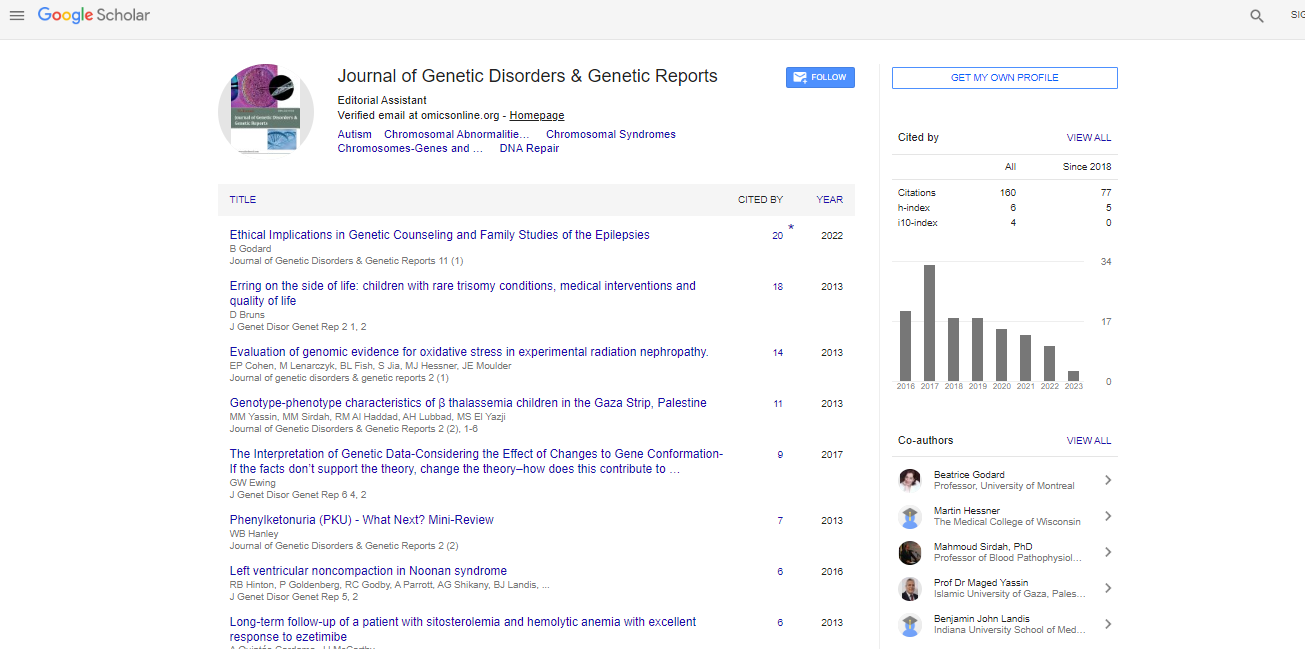Short Communication, Vol: 12 Issue: 1
Genetic Disorders and Their Inheritance Patterns
Virva Siira*
Department of Virology and Immunology, Auckland Hospital, Park Rd, Grafton 1010, Auckland, New Zealand
*Corresponding Author: Virva Siira,
Virva Siira, Department of Virology and Immunology, Auckland Hospital, Park Rd, Grafton 1010, Auckland, New Zealand;
E-mail: VirvaSiira@adhb.govt.nz
Received date: 25 January, 2023, Manuscript No. JGDGR-23-92051;
Editor assigned date: 27 January, 2023, Pre QC No. JGDGR-23-92051(PQ);
Reviewed date: 13 February, 2023, QC No. JGDGR-23-92051;
Revised date: 20 February, 2023, Manuscript No. JGDGR-23-92051(R);
Published date: 27 February, 2023, DOI: 10. 4172/2576-1439.1000191
Citation: Siira V (2023) Genetic Disorders and Their Inheritance Patterns. J Genet Disor Genet Rep 12:1.
Description
Genetics is the study of how genes and traits are inherited from one generation to the next. Genes are segments of DNA that contain the instructions for building proteins, which are the building blocks of life [1]. Inherited variations in genes can lead to differences in traits, such as eye color, height, and susceptibility to certain diseases [2].
There are many different branches of genetics, including classical genetics, molecular genetics, and population genetics. Classical genetics is the study of how traits are inherited and how they are expressed in offspring [3]. Molecular genetics focuses on the structure and function of genes at the molecular level, including how genes are regulated and how they interact with each other [4]. Population genetics is the study of how genetic variation changes over time within populations, and how it can lead to the evolution of new species [5].
Recent advances in genetics have led to a greater understanding of the genetic basis of many diseases, including cancer, heart disease, and neurological disorders [6]. Genetics is also playing an increasingly important role in personalized medicine, as researchers develop new ways to identify genetic variations that may affect a person's response to certain medications or treatments [7].
Overall, genetics is a rapidly evolving field that is essential for understanding the biological basis of life and the factors that contribute to genetic diversity and disease.
Genetic disorders are caused by mutations in one or more genes that lead to changes in the normal functioning of cells and tissues in the body [8]. These disorders can be inherited from one or both parents or can occur spontaneously as a result of new mutations that occur during the development of an individual.
Inheritance patterns that can lead to genetic disorders
Autosomal dominant inheritance: This pattern of inheritance occurs when a mutation in a single gene on one of the 22 pairs of autosomes (non-sex chromosomes) is sufficient to cause the disorder. An affected individual has a 50% chance of passing on the mutation to each of their children.
Autosomal recessive inheritance: This pattern of inheritance occurs when an individual inherits two copies of a mutated gene, one from each parent. An individual with one mutated gene is called a carrier and typically does not exhibit symptoms of the disorder. However, if two carriers have children together, there is a 25% chance that each child will inherit two copies of the mutated gene and develop the disorder.
X-linked dominant inheritance: This pattern of inheritance occurs when a mutated gene on the X chromosome (one of the two sex chromosomes) is sufficient to cause the disorder. Females are more likely to be affected because they have two X chromosomes, while males have one X and one Y chromosome. If a female has the mutation, there is a 50% chance that each of her children will inherit the mutation.
X-linked recessive inheritance: This pattern of inheritance occurs when a mutated gene on the X chromosome is necessary to cause the disorder, but females have two X chromosomes and males have only one. Males are more likely to be affected because they do not have a second X chromosome to compensate for the mutated gene. If a female is a carrier of the mutation, there is a 25% chance that each of her male children will inherit the disorder [9].
Some examples of genetic disorders include cystic fibrosis, sickle cell anemia, Huntington's disease, hemophilia, and Down syndrome [10]. Understanding the inheritance patterns of these disorders can help individuals and families make informed decisions about genetic testing, family planning, and medical management.
References
-
- Pauls SU, Nowak C, Bálint M, Pfenninger M (2013) The impact of global climate change on genetic diversity within populations and species. Mol Ecol 22: 925-46
- Ha TY (2011) MicroRNAs in human diseases: from cancer to cardiovascular disease. Immune Netw 11: 135-54
- Goldmann JM, Veltman JA, Gilissen C (2019) De novo mutations reflect development and aging of the human germline Trends Genet 35: 828-39
- Ridley RM, Frith CD, Crow TJ, Conneally PM (1988) Anticipation in Huntington's disease is inherited through the male line but may originate in the female. Journal of medical genetics 25: 589-95.
- Calin A, Brophy S, Blake D (1999) Impact of sex on inheritance of ankylosing spondylitis: a cohort study. Lancet 354: 1687-90
- Passalent LA (2011) Physiotherapy for ankylosing spondylitis: evidence and application. Curr Opin Rheumatol 23: 142-7
- Sharan D, S Rajkumar J. (2017) Physiotherapy for ankylosing spondylitis: systematic review and a proposed rehabilitation protocol. Current Rheumatology Reviews 13: 121-5
- Sag E, Tartaglione A, Batu ED, Ravelli A, Khalil SM, Marks SD, Ozen S (2014) Paediatric rheumatology. Clin. Exp. Rheumatol 32: 07-113
- Aikawa NE, Sallum AM, Pereira RM, Suzuki L, Viana VS et al (2012) Paediatric rheumatology. Clin. Exp. Rheumatol 30: 445-9.
- Raab A, Sengler C, Niewerth M, Klotsche J, Horneff G et al (2013) Paediatric rheumatology. Clin. Exp. Rheumatol 31: 796-802
 Spanish
Spanish  Chinese
Chinese  Russian
Russian  German
German  French
French  Japanese
Japanese  Portuguese
Portuguese  Hindi
Hindi 



